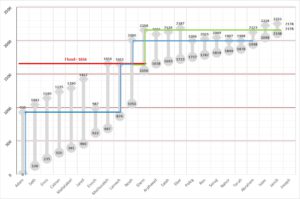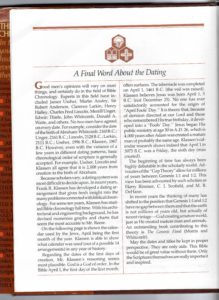A few months ago, someone approached me and excitedly asked me, “Did you know that the Old Testament is not in chronological order?”. This person continued by sharing that they had just discovered that some of the prophets had actually lived during the time of the kings of Israel and of Judah.
The interesting thing is, that this person was not the first one to make this same comment to me. The books of the typical Bible Old Testament are not ordered chronologically, and this can be confusing to someone who doesn’t know, and maybe thinks, that events run chronologically from Genesis to Malachi.
It takes a lot of work, and going back and forth, to figure out where many of the prophets fit into the story of the Old Testament. Most of us probably do not have the capacity of sorting it all out. Not being able to do the work, does not have to limit our opportunity for reading it. Thankfully, many historians have taken on the task and have shared their results. In future posts, I will take a closer look at some of these findings and their importance in the overall picture painted by the Creator.
One thing for sure is, that a reading through the Bible chronologically will help your understanding of Biblical events in a remarkable way.
Old Testament Chronology
In order to get a feel for what the Bible is all about, it is important to understand the general chronology of events that take place.
The Bible starts with the account of creation. It is then punctuated by some key events from the flood, to the life of Abraham, to the Israelites leaving Egypt and entering the land of Canaan. From there, the story follows the Israelites to the point of exile from the promised land to their eventual return of the tribe of Judah.
The typical Old Testament history spans a time of 4,000 years or so. I include here some rounded dates for ease of remembrance. A more detailed study of the chronology would be needed in order to isolate the actual dates and to understand the variance of actual dates established by different historians. I will try to address this in a future post but in the meantime, here is a glimpse of a chronological graph from Adam to Joseph I prepared for different study.
- Creation: 4,000 B.C.

- Flood: 2,300 B.C.
- Abraham: 1,960 B.C.
- Israel in Egypt: 1,660 B.C.
- Israel entering Canaan: 1,420 B.C.
- The fall of Israel: 720 B.C.
- The fall of Judah: 580 B.C.
- Judah returns from exile: 510 B.C.
Between the Testaments
After the book of Malachi, which historically is the last book of the Old Testament, there are about 400 years of silence. Some of the books from the Apocrypha (included in some versions of the Bible) deal with this time frame and offer some historical context of the social and political environment during that era of history.
Linking to world history, this would be the time frame when the Greek Empire rose to prominence from 330 B.C. until 60 B.C. when the Roman Empire subsequently rose to power. This sets up the climate for the events that take place in the New Testament, when the land of Israel (Judea) was under Roman rule at the time of the birth of Jesus Christ.
New Testament Chronology
The New Testament basically starts with the events surrounding the birth of Jesus Christ. The New Testament Gospels are four separate accounts of the life of Jesus Christ. The authors reference similar events but not always in the same Chronological order. This has confused many readers into thinking that there are multiple similar events or that all similar events only refer to one particular event. A thorough study of the Gospels helps sort out these issues; a study I hope to include in a future post. The book of Acts comes chronologically after the gospels and is actually a sequel to the book of Luke.
Some of the epistles correspond to events found in the book of Acts. Other epistles were written by Paul after the events recorded in Acts and before his death in about 68 A.D. The latest book included in the New Testament is the book of Revelation. As can best be determined, this book was written around 96 A.D. by John who was the last of the Apostles to die.
Some of the widely accepted dates established by historians are as follows:
- Birth of Jesus Christ: anywhere from year 3 A.D. to 5 B.C.
- Death of Jesus Christ: anywhere from 29 to 33 A.D.
- Death of the Apostle Peter and the Apostle Paul: 67 or 68 A.D.
- Destruction of Jerusalem: 70 A.D.
- Death of Apostle John: 100 A.D.
World History and Bible History
Many people feel that the Bible is an isolated account of human history and that it does not really fit into the world history timeline. This is an erroneous supposition. Although secular history is not needed to prove the truth of the Scriptures, it is interesting to note that secular history agrees and coincides with Biblical history at many points along the timeline.
I am not a historian and, to be honest, I never had much of an interest in history until I started studying the Bible in more detail. That is one of the reasons why I choose to leave the historicity debate to the historians. I am convinced that the events recorded in the Scriptures are real events and firmly belong in the Annals of Human History.
There are some historians that have done a lot of leg work to be able to do a side by side comparison of secular history and biblical history. Although there are still some uncertainties surrounding the subject, and not all the historians are in agreement over all the dates, there is definitely enough information available for anyone to come to the conclusion that what is included in the Word of God does have historical weight.
Arguments can certainly be made one way or another and I encourage you to read this PDF copy of the page A Final Word About the Dating taken from the introductory pages of The Reese Chronological Bible. Feel free to print it off and add it to your study binder.
Action Point: putting it all in order
- If you have interest in reading the Bible in chronological order I encourage you to visit here to see the selection of Chronological Bibles available to you. Thankfully, we do not have to do all the work of organizing the text, someone has already done it for us.
- For a detailed review of the Reese Chronological Bible that I use, click here
- I have prepared some printable Bible Study lessons dealing with the general chronology covered by the Bible.
- Download the Printable Bible Chronology PDF worksheet for the New Testament (to be available soon)
- Download the Printable Bible Chronology PDF worksheet for the Old Testament (to be available soon)
- The chronological graph from Adam to Joseph is an example of a more detailed study of Bible chronology
- You can download the Adam to Joseph chronological chart here
Thank you for this awesome article. I have read all the Bible one year ago and I am thinking of reading it again from the start. You explained very well how one should read it and I must say that it is not easy especially for beginners because you need to understand the essence.
Great job reading through the Bible. You have done what many have not been able to do and you now have a great foundation. Keep moving forward on your quest to understand the Scriptures. The website has some good introductory lessons about the Bible with printable worksheets and videos. If I can be of help in any way, please let me know.
Yes, it is very difficult to understand the Bible. I’ve tried to read it but I get very confused as to what happened and when. I suppose the Bible cannot really be read as one story from cover to cover. Your summary is very helpful to put the events described in the Bible in a chronological perspective.
I would encourage you to visit What is the Bible: one BIG book? or a LIBRARY of books? The post shares a different perspective on how you can view the Bible; it includes a printable worksheet and a short video. If you treat it as one big book, it certainly is an overwhelming challenge to read it and understand it. Don’t give up on trying to read it and understand it. I am here to help in any way I can.
Thank you so much for sharing this information. As a pastor, it is good to see that people are sharing the truth about the Bible. This isn’t always the case. The Bible can appear confusing, but when read in chronological order, it becomes a lot clearer to the reader.
I enjoy the graph you created for the span from Adam to Joseph. It is quite concise and may be useful to the reader to follow along in the lives of these Old Testament legends.
I appreciate you briefly talking about the 400 years of “silence.” Even though it seems as if God was silent during this time, we can see through history that He was anything but silent! The rise of the Roman Empire gives the background for the birth of Christ. Thank you for presenting this in an understandable way.
I think your site is great and I will be recommending it to members of the church’s congregation! Keep up the sharing of the truth!
Thank you so much for your encouragement. I sense that you share a passion for the Scriptures, and a love for the truth of the Word of God. May the Lord bless you.
Since you mentioned the graph from Adam to Joseph, i am going to throw you a little bone on a post I will be doing in the not too distant future. How many direct steps from Adam to Moses (the shortest chain of people who knew each other, and would have likely spoken to each other, as the account of creation was passed along)?
I’ll leave you hanging, I was blown away by what I found.